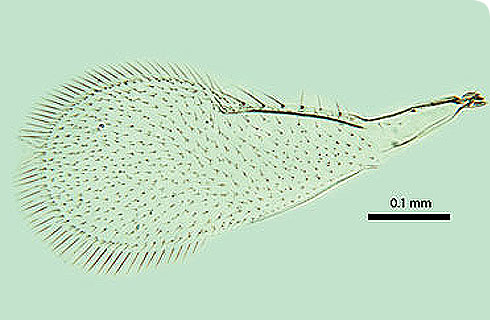Biology
The wasp is tiny - approximately 1mm - smaller than a pinhead.
It is a solitary, primary endoparasitoid in the sessile, developmental stages of whiteflies (Aleyrodidae), known as ‘nymphs’ and ‘puparia’.
Adult female E. formosa locate plants infested with whiteflies using their olfactory and visual senses, searching for hosts on the upper and undersides of leaves.
As well as killing hosts by oviposition, female wasps also pierce whitefly nymphs with their ovipositor and feed on exuded haemolymph.
Wasp eggs are unfertilised as E. formosa is a uniparental (thelytokous) species that does not need to mate to produce females. This characteristic is caused by infection with a recently-discovered bacterium - a Wolbachia species.
E. formosa lays eggs preferentially in the third and fourth instar nymphs, and prepupae, laying about 5 eggs a day over a 12-day life span, thus laying about 60 eggs in total.
Each female will also host-feed on about 3 nymphs every day. The total number of whitefly nymphs killed during a female’s lifetime is almost 100 (Hoddle et al, 1998).
Thelytoky can be suppressed by destroying the Wolbachia bacteria with antibiotics fed to the adult females, or exposure to high temperature. However, males resulting from this treatment are not able to inseminate females (Kajita, 1989; Zchori-Fein et al, 1992).
One of the important attributes leading to this wasp’s success is its very high degree of host-specificity. After almost a century of detailed study, it is known to develop successfully in just 16 species of whitefly hosts around the world.
Toolbox
Glossary
Haemolymph
Fluid in the circulatory system of arthropods.
Olfactory
Sensory system for sense of smell.
Oviposition
Laying eggs using an organ called an ovipositor.
Thelytokous
Process by which female offspring are produced from unfertilised eggs.
Parasitoid
Depends on another species for survival, and kills it in the process.
